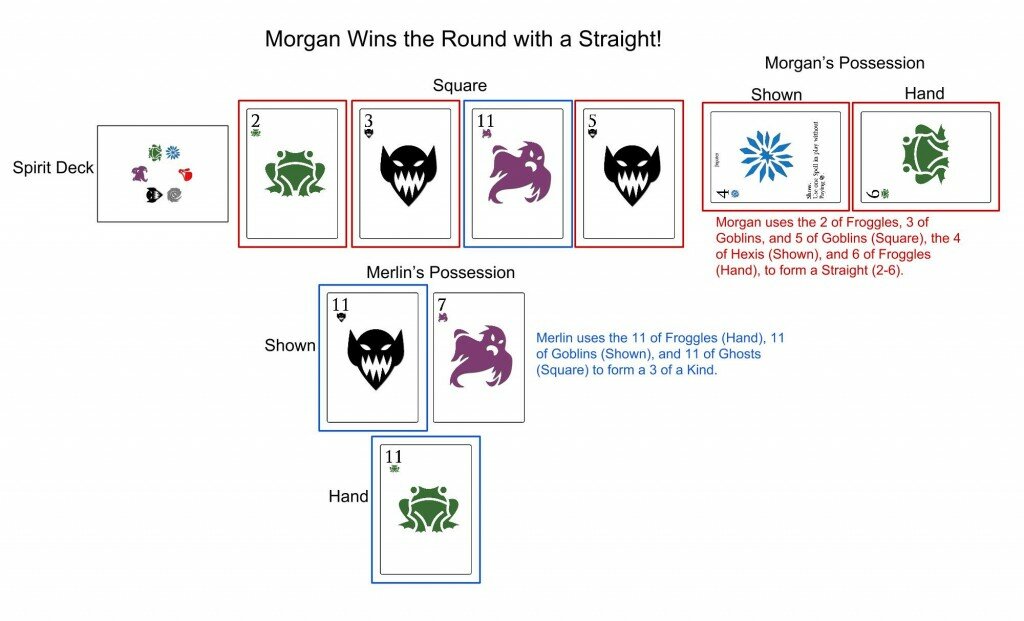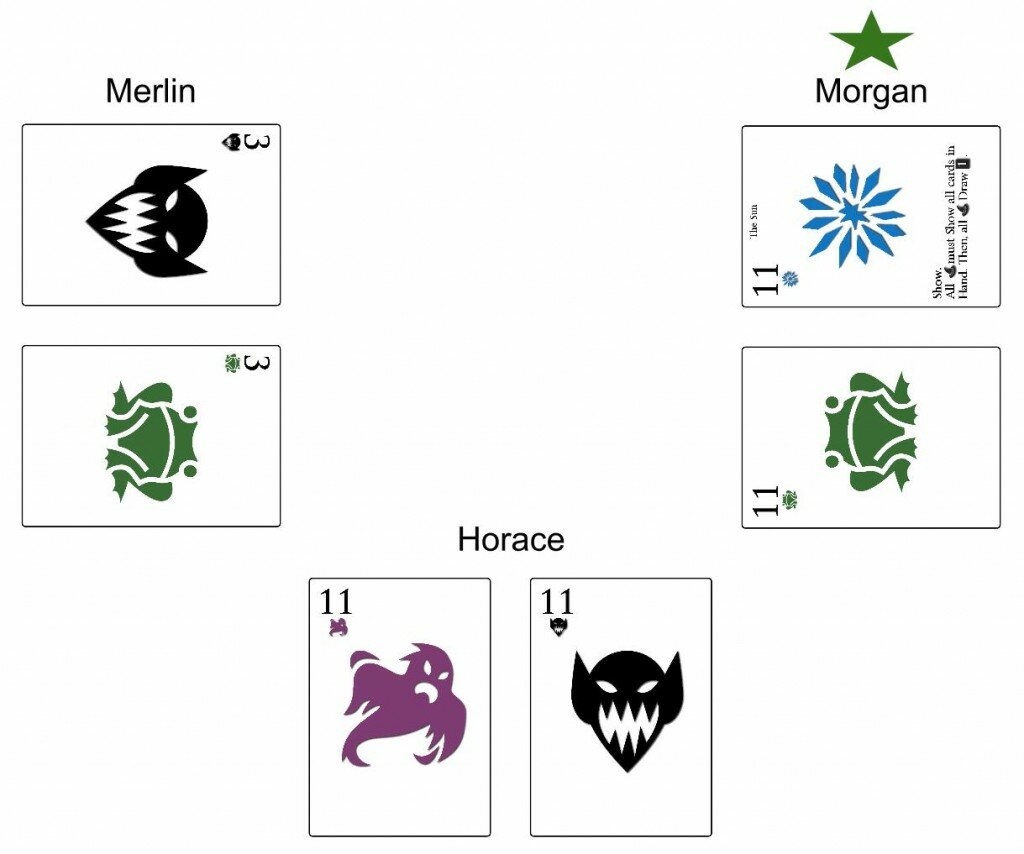Post by: Grant Rodiek
A fundamental problem with every board game is that a game designer doesn’t ship with every copy of the game to teach it to customers. This is a difficult problem to solve before the advent of cloning or teaching droids.
If you’ve read my blog, you know that I believe very strongly that accessibility, or the lack thereof, is a key component to the growth or stagnation of our hobby. Therefore, today we’re going to talk about diagrams and how this very crucial element should be used to improve even the simplest game.
Every player learns to play your game differently. Some people like to read, some love to watch videos, others insist on being taught, and finally, some may simply be visual learners. Most likely, most people are a little bit of everything. Every designer has the budget and time to write clean rules — it just takes practice. Furthermore, every designer has the skills to create even the most rudimentary diagrams to illustrate even the simplest point.
Remember, a picture is worth 1000 words. And a picture paired with 1000 words is a far superior rules document. My goal for this post is to give you a variety of examples and cases from my own games and others to demonstrate how to use diagrams to improve your rules.
One Quick Note: Do not bother with diagrams until your rules are relatively stable. You’ll kick yourself if you have to constantly re-make the diagram to match your shifting rules. Wait until you’re at a point of relative stability, or a big moment (Con, pitch) to do it.
If you want to see my words in action, check out the Hocus Poker rules. They now contain diagrams for many aspects of the rules.
What should diagrams teach? Diagrams should teach anything that can be misconstrued with written communication. A board game rule booklet is a construction manual, a how to manual, and a trouble shooting manual all in one.
Construction Manual: For construction, let’s look to some of the best manuals in the business: Lego and Ikea. Without a single word, they teach people how to communicate elaborate, intricate things. Or, cheap plywood stools.
Therefore, a standard for game diagrams is how to setup the board and play space. Unless your game has a single deck as a component, this holds great value. Not only does it clear up any confusion surrounding the interpretation of the text, but it is your chance as the designer to show your players the ideal way to setup the game to maximize their space.
In the diagram above, I demonstrate how to setup the Actions and Spells. I provide context and examples for how the Mana and Rune tokens will be used. I give an idea for how players should sit, and remind them subtly that hands are private (face down). Finally, I show where to setup the square. This is all fully explained in text in the rules, but providing an image with captions really drives it home.
Use diagrams to demonstrate how precisely to setup the game so that there are no questions from your players on whether they read correctly.
How To: There are some standards in games that don’t need visual backups. Shuffling, for example. Then again, Pandemic, which I consider a standard setter for accessibility, has a diagram that shows you how to hold cards in your hands (in the first edition, at least)!
Here: Just go read Pandemic’s rules.
What do I want you to take away from this? Pandemic uses a visual to help explain every single choice you can make in the game. They tell you how to move your pawns, what cards you spend to cure, how you remove cubes, how to travel. All via diagrams. I assure you that a large part of Pandemic’s main stream success is how difficult it is to screw up your play experience. People hate feeling stupid. This is one of the reasons they don’t play board games. Pandemic does everything it can to ease this.
For Hocus Poker, we created diagrams to cover a few things with which people might have confusion, each shown below: Paying to activate spells, creating a hand, and tie breakers.
Each of these is backed up with a text explanation, but each is intended to drive home things that should be relatively simple.
The key element we’re trying to communicate in the diagram immediately above this is that you stack your Mana and that you do so above the Spell cards. The text explains the finer points, but driving home visually what it means to “stack” is really key.
Here, we used this snapshot of a game to outline several points. One, a player’s possession and that it includes both their hand and shown cards. We also wanted to highlight that players can build hands using their possession and the Square. Thanks to a tip from a reader, we used blue and red outlines to note one example player’s hand from another. Finally, this helps reinforce that some hands are better than others.
For this last one, we’re explaining the tie breakers. You see three hands in the third image, each a pair of 2 matching cards. The first tie breaker is that 11 is better than 3. That knocks out Merlin. The second tie breaker is that the best Arcana card in ties wins. Morgan is the only one with an Arcana (the 11 of Hexis), so she wins.
One thing you hopefully noticed in both my examples and the far superior Pandemic ones is the sense of context. The diagrams are not just useful for teaching a single item, but multiple items wrapped together in context. Every diagram is an opportunity to teach a new thing and remind the player about another thing they just learned.
The Trouble Shooting Guide: We use diagrams to teach players to setup correctly. We then use diagrams to teach the basics. Diagrams should then be used to teach the difficult stuff.
One thing I like about the rules for Horus Heresy is that within their diagrams, they not only show you what you can do, but what you can’t. Check out the movement diagram on page 22.
If you’ve ever tested a game, you know that immediately after you or your rules explain what a player can do, players will ask if they can’t do something. I have mixed feelings on how to solve this. If your rules specify everything a player can’t do, the document will soon grow to 300 pages. However, diagrams are a great way to highlight the most often asked issues.
In Battle for York, players are allowed to completely abandon a region on the board. This is different than Risk. Therefore, I used a diagram to show that you could move all your units and therefore subtly teach that, yes, it’s okay to leave a territory naked.
In addition to edge cases and examples like the ones above, diagrams can be used to demonstrate written rules whose implications may not be immediately clear. For example, in Sol Rising, activated Units can Move, Attack, Change Formation, and Activate Abilities in any order. However, players who have played Memoir ’44 or Summoner Wars may think they need to move first, then attack. OR, they may think that they can attack, then move, but they need to do them entirely as a chunk. Not true!
Therefore, I used diagrams to show an activated Squadron moving one space, attacking, then moving the remaining two spaces and changing formation. This would have been a cumbersome and easily misinterpreted paragraph in the rules booklet. But, as a captioned image, it illustrates the point perfectly.
How should you create your diagrams? You have so many tools at your disposal! Google Drawing is FREE and is really fantastic for creating simple diagrams. Their tools let you create simple shapes, like cards, very quickly. And, you can import images to use as well. You can also setup your prototype and take a Photo using a smart phone.
You may laugh, but it’s possible to even doodle something on pen and paper, then scan it into your rules. You’d be shocked to find what a square with an arrow can teach your players.
What are your favorite examples of diagrams in rules? What are some tricks you’ve found useful for crafting diagrams? What did I get wrong? Share it in the comments below.




Pingback: Today in Board Games Issue #188 - Maha Yodha Review, Designer Wisdom, MoBG Chats - Today in Board Games
Pingback: News Bits: 6/23/2014 | iSlaytheDragon
You took the words right out of mouth!
Excellent article, sir. Thank you especially for the diagrams illustrating uses for diagrams.
Thanks for the kind words, Derik!
Hey Grant, would you consider letting me use this as a guest post over on Rulebook Review? This is just such a good article on diagrams and would be awesome and relevant.
Plus, I might throw in a picture of Susan the Mustache and a certain Corgi I know…
Feel free to link it on your site and what have you, but I’d prefer you don’t copy and paste the text.
I was hoping to just use a link and send people this way, I was working on a similar article myself but why write it all up when such an excellent job was done here? Thanks for the permission